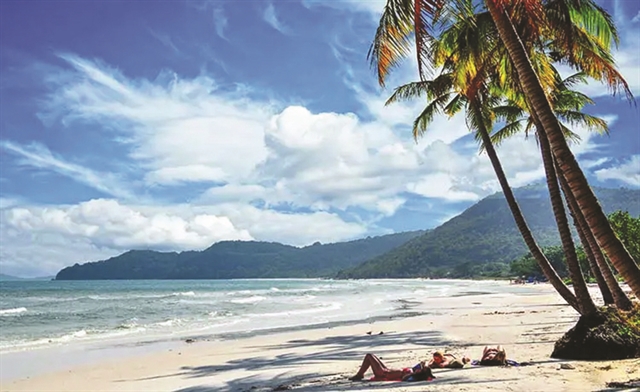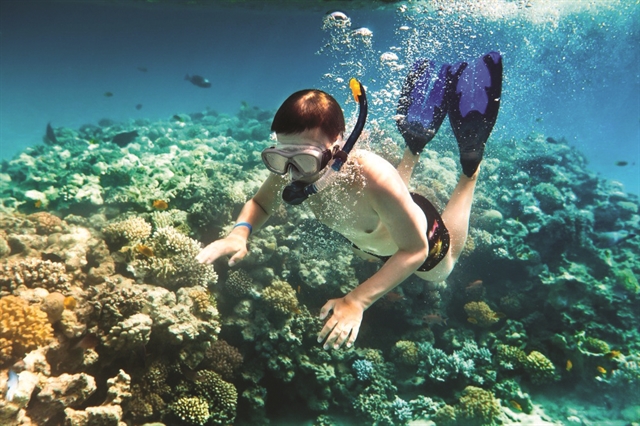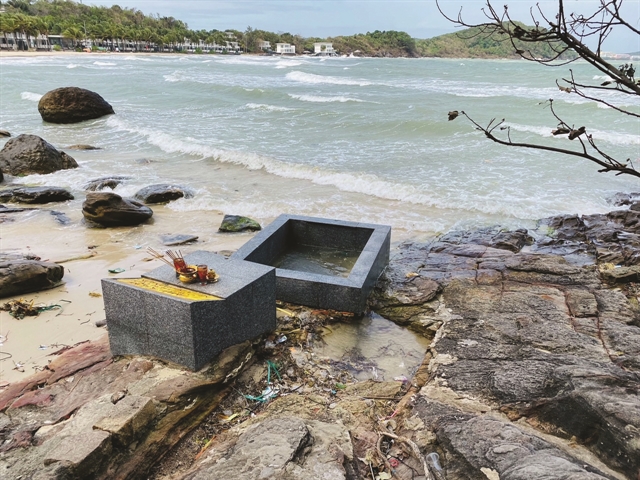I have visited the pearl island many times and still lured by its pristine landscapes.In my most recent trip, I stayed at Cape Ông Đội, where the land strip is surrounded by the sea.
Lê Hương
I have visited the island of Phú Quốc several times, but I am still lured by its pristine landscape in the southern province of Kiên Giang.
In my most recent trip, I stayed at Cape Ông Đội, where a peninsula is surrounded by the sea.
The cape is located at the end of An Thới Town, some 32km from the city of Dương Đông ò the island district, and has been considered as a rare tropical sea paradise with long white sand strip next to spectacular cliffs. From the cape, people can see sunrise and sunset.

An aerial view of Cape Ông Đội. Photo selavia-phuquoc.net
Visitors can enjoy fresh air, pristine nature with a range of mountains running to the turquoise and quiet sea.
You will also be stunned by the various shapes of rocks and cliffs, prime forests and immense hills with panorama views. The natural landscape is like a beautiful painting, which is why the area attracts so many high-end resorts.
The cape is home to multi-coloured coral reefs to satisfy visitors’ desire to explore the sea world. There are many diving tours combining with tours to nearby fishing villages, pearl raising farms and meals of local delicacies.
Staying at the cape, one should not miss the chance to stroll along the beach to see the sunrise or admire a romantic sunset.

Khem Beach with pristine beauty. Photo dulich.net
The cape is also an ideal place for people to try fishing on calm sea days. Taking a boat to the sea, visitors can fish in a small group or join a fishing tour, or join a bigger ship to fish in deeper seas.
Khem Beach is a wonderful beach nearby, where the beach curves along the cape and you can see the clear sea.
The smooth white sand strip is striking in the middle of a green lush forest and immense blue sea. The area forms a bay with the most beautiful sand strip areas in the island.

Diving to see the coral reef is highly recommended to visitors to Cape Ông Đội. Photo didulich.net
Historical traces
The name Cape Ông Đội is associated with a story involving the fighting of King Gia Long against Tây Sơn troops.
According to historical documents, when Tây Sơn farmer insurgents from today’s central province of Bình Định led by the three Nguyễn brothers fought against the then ruling Lord Nguyễn in Việt Nam's southern realm, Lord Nguyễn Ánh had to flee to Phú Quốc Island around late 18th century.
The lord’s ship suddenly hit a rock in the sea and could not move, while the Tây Sơn troops were chasing after them.

The water source at the Holy Well remains fresh even though it is located by the sea. VNS Photo Lê Hương
In that fatal moment, one of his guards bravely jumped into the sea to help free the ship from being wrecked. Thanks to this, the Lord’s ship quickly escaped from the Tây Sơn troops. Unfortunately the soldier drowned under the strong waves.
Cape Ông Đội
In 1787, Nguyễn Ánh, with the support of the French, returned to take power back in Gia Định (today’s HCM City). He came to the throne as King Gia Long, the first king of the Nguyễn dynasty. To commemorate the brave soldier, who saved him from the Tây Sơn troops, the King came back to the site to host a memorial ceremony and named the cape, "Cape Ông Đội".
Since then, the site has become a holy place for locals and has attracted many visitors with the legends.
There is a fresh water well by the beach, which was named Giếng Tiên (Holy Well), Giếng Ngự (Royal Well) or Giếng Gia Long (Gia Long Well).
Local residents said the well is a small water source running down from the mountain. Water fills up the shallow well, and even when the tide rises high, the water remains fresh, not salty.

A shrine dedicated to King Gia Long by the Holy Well. VNS Photo Lê Hương
Legends have it that when Nguyễn Ánh fled here, his troops ran out of food and fresh water, causing them to panic.
Nguyễn Ánh put his sword down onto the rock, looking up to the sky and shouted: “If heaven makes me a king, then please give us fresh water and food.”
When he just completed the pray, a source of fresh water ran out from the crack he made on the stone by his sword. Then fish swam up from the sea. His troops had enough water and food to survive. That kind of fish was then named cá cơm (anchovy).
Hundreds of years later, the water source became a rare well of fresh water in the middle of the wild forest, right by the sea.
Cao Văn Lượng, a local elder, said he did not believe in the legends much but he saw the well the same as today when he was small.
“Today, the well has been renovated with some bricks so that it can store more water,” he said.
The water source comes from the rock, not from a soil foundation like other man-made wells. There are also some footprints on the rock, which are said to be the king’s.
There is also a rock in the form of a big chair at a rocky site at the Cape, which is said to be the king’s chair when he was here.
“There are many historical heritage sites throughout the island,” said Phan Văn Đen, who lives nearby. “My neighbours and I have always been proud of the Holy Well. Each time we visit the well, we would fetch home a bottle of water to drink, wishing for better health and luck.” VNS